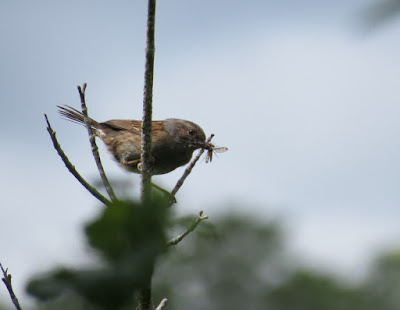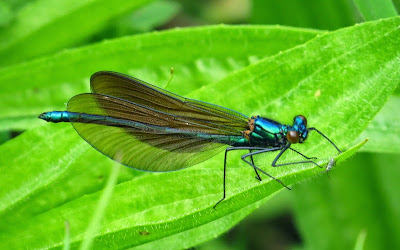OK, the big day. We had a great day. Our "patch" was actually three patches lumped into one. Mostly, Dave and I covered Morton Bagot, Jon & Mike covered Middle Spernal Pools, and Haselor, while John covered Haselor and a pond next to a dovecote, the name of which escapes me in my currently befuddled state.
Importantly we all met up at the pub at lunchtime to compare notes.
 |
| The dream team! From the left, Dave, John, Mike, Jon, and me |
Time to rewind back to the start. I was the first into the field, arriving at Morton Bagot at 04.28. As it got light, the morning revealed itself to be cloudy and cold, with a moderate to fresh westerly. My first bird was a singing Robin, but within a minute my early start was vindicated by the hooting of numerous Tawny Owls. I did a full circuit as the light came up, seeing useful species such as a pair of Little Grebes, Tufted Ducks, and hearing no less than three Garden Warblers, an unprecedented influx for the patch. Other tricky species bagged included Goldcrest, Treecreeper, Great Spotted Woodpecker, and Grey Heron.
After a short break for breakfast I was back at Netherstead on 54 species waiting for Dave to arrive. By the time he did so I had added Rook and Sparrowhawk. At this point we thought we had better see how Mike and Jon were getting on. They revealed they had started at 05.30 and had already seen what was probably the find of the day, a pair of Goosanders. Also on their list of birds they had recorded which we hadn't were Cuckoo, Marsh Tit, and Reed Warbler.
Dave and I tried for the latter at the small reed-bed. It certainly contained a Sedge Warbler, but with the wind increasing in strength nothing was singing, and we eventually gave up (while suspecting that some of the calls we had heard could have been made by a grumpy Reed Warbler.)
We chose to walk along the road, and at the corner of Bannams Wood got a really valuable bird. a Mistle Thrush flew out of the wood and away. I hadn't recorded one on the patch since the winter, and had concluded that there were none to be had.
Our next bit of luck came as we approached the pool. In the ploughed field beyond, the four Wheatears I had seen on Thursday were still present. Next came another tricky species for us, as three Starlings flew over (I later learnt that John at Haselor had seen lots and couldn't understand what all the fuss was about) but they are hard to find at Morton Bagot in spring.
We finally got to the Flash field where we saw the pair of Redshanks (Jon and Mike had seen one at Haselor by this time), and more importantly, Dave spotted the Little Owl.
Things then got even better. My visit on Thursday had led me to believe that the Teal had gone, but no, Dave spotted one on the back flash. Looking through the scope I confirmed there were actually a pair which swam into view from the surrounding vegetation. I then spotted a small plover, which gradually revealed itself to be one of the pair of Little Ringed Plovers. We had previously seen several LBB Gulls going over, but Dave next spotted two immature Herring Gulls, and shortly afterwards I located the team's only Yellow Wagtail of the day flying off, and two Sand Martins with a swirl of distant hirundines and Swifts.
We realised this was making us late for the pub, so arrangements were made for a slightly later reunion. On our way, after briefly seeing one of the Garden Warblers, we spotted a silent Cuckoo as it flew over us. Shortly afterwards we located it in a hedge.
It was slightly gingery around the neck and remained silent. Perhaps a female.
So to the pub. Jon and Mike had added a Shelduck at Haselor, and a Jay at the pub (part of the recording area?), while John revealed he had seen several Feral Pigeons and a Grey Wagtail on his patch. We counted up and concluded we were on 73 species.
After lunch we resumed our searches for any missing species. Dave and I saw a Jay on the road in front of Bannams Wood. Jon and Dave went looking for Nuthatch and various missing Tit species in Bannams Wood, without success as it turned out. On my return I thought I would scope the back flash from the road. It's very distant but at least you can seen all of it because of the extra elevation. This produced a patch year tick in the form of a
Dunlin. Chuffed is not the word. I rang Dave and Jon, who had split up by then. Dave joined me and quickly got onto the Dunlin. Then he added another bird to the day list, two Black-headed Gulls were heading north. They disappeared behind the wood before I could get on them, but luckily reappeared shortly afterwards.
We rang Mike, but by the time he got there the Dunlin had disappeared. Fortunately Jon had relocated it from the fence down at the flashes, so we headed down to get a closer look. By the time we arrived it was back on the back flash, but we eventually scoped it, and I even got a record shot when it flew.
By now I had been in the field for 12 hours, and the others were trooping off home one by one. I was left to make a final circuit on my own. This added a personal day tick, Marsh Tit, and the last team tick of the day, a calling Coal Tit.
Our final score was
77 76 species, and my personal total for Morton Bagot was a new patch day list record for me of 72 species.
I will post the full list tomorrow, and hopefully will find out how we compared to the other nine teams.



















































